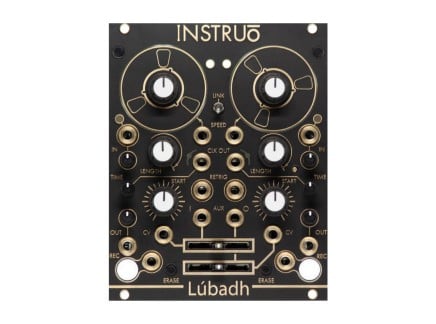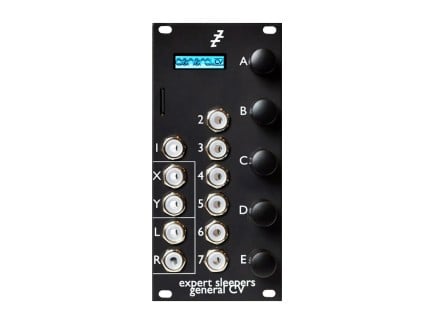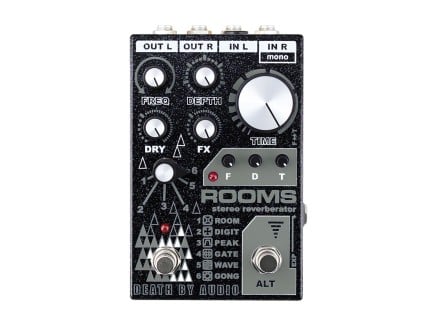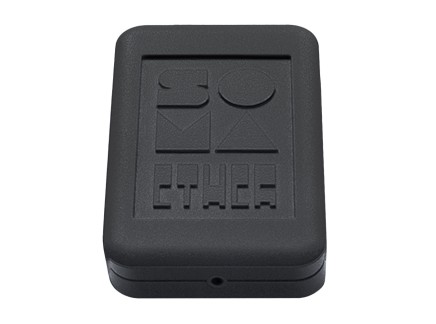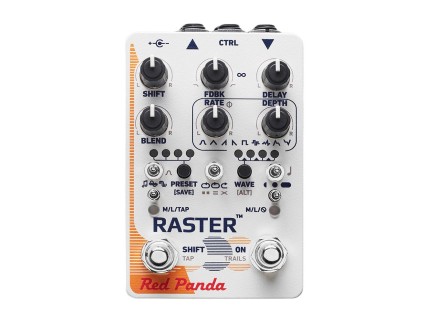Happy Halloween, ya creeps! Today, we're keepin' it light—and keepin' it dark at the same time. We're taking a listen to some of our staff's favorite spooky sounds, from scratchy ambiences and howls to straight up Frankenstein-ing your modular system.
So, get ready to join our pals Wes, Brian, Jacob, Bryce, and Erin on a terrifying journey through sound. Let's get spooky.
Wes Gets Slimy
For our first spooky sonic technique, Wes electrocutes some slime...really.
The first step to this trick is something you might have seen him do before: using the conductivity of his skin to momentarily make connections between two points in a modular synth patch. It's pretty cool, and surprisingly effective—and it's not just Wes's skin: anyone's skin can be used for this trick.
This isn't so different from the idea behind landscape.fm's AllFlesh jacks, or the touch bridges and gateways on Make Noise's Strega: simply by making physical contact with an input and output in a modular system, you can use your body like a patch cable. In fact, by changing the amount of surface area you're making contact with, you can use your body like a crude attenuator. Pretty rad.
But this also extends to other conductive materials. You could patch up a potato! Or, better yet, you could patch up some slime: creating a peculiar, squishy mixer/multiple for your signals. You can then physically manipulate the slime, exploring all the weird voltage permutations that result from its gradual deformation. So, if it never occurred to you to slime your synth...today might just be the best day of your patching life.
Brian Reaches Directly Into Your Ears
When creating unsettling, creepy sounds, sometimes the best course of action is blending organic sounds with synthesized elements. This can create an uncanny valley type of response that is just fantastic to exploit. In this particular example, we are greeted with two acoustic elements: tapping and scratching, courtesy of the Korg CM300 contact mic, as well as a clarinet, captured by the best all-round mic, the Shure SM57. By using something that is familiar we can generate trust—but then mangle and destroy it thanks to the Lubadh and Beads. By using the CV inputs for the Start points on both reels of the Lubdah, we can get sporadic, jumpy clips of sound that get further manipulated by Beads. When using Beads in this way, it works best to keep the reverb down, or modulate it so that most of the sounds are pretty sharp.
For our synthesized bit, we are using the Expert Sleepers General CV in Chord mode being slowly triggered. One very handy feature in the GCV is the built-in quantizer and transposition function, so for this, a random source is patched to trigger the Sus chord, but to make it even weirder, a pitch offset is patched in and quantized to a harmonic minor scale to keep you guessing. We used Clouds in looping delay mode for a drifting pitched-down echo, however, any delay with a pitch function, like the TipTop ECHOZ or Make Noise Echophon, can be used for a similar effect. Again, we are exploiting the uncanny valley response by using a General MIDI-based module, which features sounds that are mostly lofi samples, but when treated with an envelope, filter, and other sound sculpting effects, you can get sounds that are familiar, yet strange.
Try this for yourself by using any mic you have, a sample manipulator, and any type of effect you like. When using delays and reverbs, short ones work nicely (think Stalker sound design) and keep your sounds sparse. Your sounds need time to breathe and silence is often the best way to generate tension.
Jacob's Brewing Cauldron of Horrific Sound Design
A lot of my favorite pedals are commonly known for creating beautiful, shimmering ambiences—but that's not exactly "spooky" is it? But using effects less as tools for some desired musical outcome and more as platforms for explorative sound design can quickly bring you into unfamiliar sonic territories, regardless of what instrument or sound you're running through them.
For my spooky sounds, I'm mainly relying on three pedals plus a Eurorack module: Eventide's MicroPitch and UltraTap, the Chase Bliss MOOD, and Beads from Mutable Instruments . These are very flexible effects with tons of "sweet spot" settings, but I'm going to be leaning into their weirder sides to conjure up some unsettling sonic sorcery.

Eventide has an illustrious history of producing pitch-shifting and delay effects, and their MicroPitch pedal is another entry in this catalog, specializing in a detuning sound that is similar to chorus but without the characteristic warbling modulation. Its typical use case is for thickening up sounds, a common production trick that Eventide calls "secret sauce." But by dialing in short delays and moderately high feedback, it's possible to achieve pitch glides—one going up, and one going down, given that there are two delay lines with slight pitch detuning in one direction or the other. For my sounds in the video, I'm using only the descending delay, for it turns already low sounds into an ominous rumble that would shake anyone to their core.
Though it isn't a pedal, I find myself using throwing Beads onto my pedalboard all the time. As far as real-time granular processing is concerned, Beads is the gold standard in my eyes. Like Clouds before it, Beads specializes in dense granular clouds and offers plenty of flexibility in defining the size, density, and pitch shifting of grains. Though the common Rings into Clouds or Rings into Beads patches have given this module a reputation for glistening octave-up granular swarms, shifting grains down an octave combined with more abrupt grain envelopes offers a sinister twist to an otherwise typical patch. I like to place this effect after MicroPitch to chop up the linear downward pitch ramp.
Another of my favorites from Eventide, UltraTap is a standalone version of an effect that first appeared in their H9 pedal. It's a supremely flexible multi-tap delay, with numerous controls on tap (pun intended) for skewing the timing of taps, "slurm"-ing them all together, and using internal modulation for glitch and swell effects. UltraTap is an excellent choice for smearing sounds together in a slightly different way than a reverb might, and that's how I'm using it in the video above. For atonal, percussive elements, transients become masked and stretched, whereas any discernible pitches that have already been mangled by MicroPitch and Beads become sustained in a surreal, otherworldly fashion.
MOOD is a popular pick for ambient pedal stylings, thanks to its unique methods for looping, re-looping, affecting your loops, and more. The reverb on its left channel can be dialed in for multitap-like sounds or turned into a dense, highly diffused reverb, which is always helpful when you want to change, well, the mood of a sound. But we're also going to turn to the time-stretching mode on the looping channel for our spooky MOOD sounds. Capturing snippets of sounds and zooming in with a microscopic time-stretching can yield thoroughly bizarre and petrifying noises. Placing MOOD at the end of the chain so that it is listening to everything we've done up to this point, and blending in its special flavor of audio manipulation is the final touch for our witch's brew of creepy noises.
Pushing effects outside of their usual purposes is a surefire way to uncover some weird, unsettling, or spooky sounds. It's also a great way to learn more about the tools that you use to make music, whether it's pedals, Eurorack modules, or plugins. Plus, it's always fun to explore the full capabilities of something and use it in ways that other people might not be doing.
Bryce's Dungeon
If you know our pal Bryce, you know he's always spooky. Bryce has talked about creative effect combinations for bass on our channel before, and today he's bringing out his eeriest tricks—and believe me, they're also a treat.

In this example, Bryce is leveraging a technique similar to Brian's pitch-shifting delay on the Mutable Clouds, or Jacob's use of the Eventide Micropitch—but instead of pitch shifting, he's using frequency shifting to create some otherworldly, dissonant atmospheres. Specifically, he's using the Red Panda Raster 2, a delay pedal with a ton of opportunity for creative sound design.
Among Raster 2's finer points is its ability to insert pitch shifting and frequency shifting into a delay line's feedback loop—creating repeats that get progressively higher or lower in pitch as they trail out. When using frequency shifting in this context, you can create spiraling, evolving, clangorous, unsettling soundscapes.
But for Bryce, that's still not creepy enough. Busting out the sure-to-terrify Death by Audio Rooms stereo reverb, the Raster 2's eerie atmospheres extend into the infinite—turning a peculiar, spiraling mass of sound into something distorted and expansive. With only two pedals, he's created an ideal horror soundscape: that's creepy efficiency at its finest.
Happy Halloween, Ya Ghoulie!

Enjoy the holiday! Scare your neighbors! Scream into a Metal Zone! Sacrifice your oldest Eurorack module! Conjure an astral connection with the last piece of gear you broke by pouring slime onto it! Drag some chains on top of a contact mic! Pick up that weirdly-timed phone call from an unknown caller! Make some popcorn! Look in a mirror only to see nothing staring back at you!
And most importantly, go out, make some noise—and have fun, you creepy kooky ghoulie goblin!






